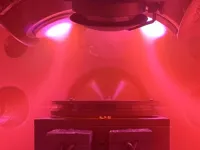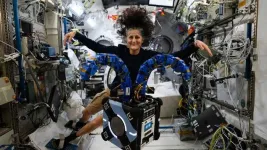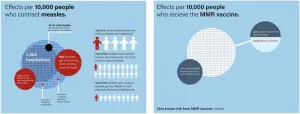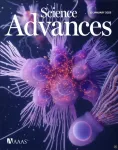(Press-News.org) Researchers have amassed vast single-cell gene expression databases to understand how the smallest details impact human biology. However, current analysis methods struggle with the large volume of data and, as a result, produce biased and contradictory findings. Scientists at St. Jude Children’s Research Hospital created a machine-learning algorithm capable of scaling with these single-cell data repositories to deliver more accurate results. The new method was published today in Cell Genomics.
Before single-cell analysis, bulk gene expression data gave high-level but unrefined results for many diseases. Single-cell analysis enables researchers to look at individual cells of interest, a difference akin to looking at an individual corn kernel instead of a field. These detailed insights have already made breakthroughs in understanding some diseases and treatments, but difficulty replicating and scaling analyses for data that keeps increasing in size has stymied progress.
“We’ve implemented a new toolset that can be scaled as these single-cell RNA sequencing datasets continue to grow,” said corresponding author Paul Geeleher, PhD, St. Jude Department of Computational Biology. “There has been an exponential explosion in the compute time for single-cell analysis, and our method brings accurate analysis back into a tractable timeframe.”
All techniques for studying single-cell gene expression create large amounts of data. When scientists test millions of cells simultaneously, the amount of computer memory and processing power needed to handle the data is enormous. Geeleher’s team turned to a different kind of hardware to help solve the problem.
“We created a method that uses graphics processing units or GPUs,” said first author Xueying Liu, PhD, St. Jude Department of Computational Biology. “The GPU integration gave us the processing power to perform the computational load in a scalable way.”
Unsupervised machine learning for single-cell analysis
The volume of data often forces researchers to make concessions and assumptions that introduce biases when conducting analyses with standard methods. The St. Jude scientists used an artificial intelligence approach that removes such bias from these selections.
“Our method uses unsupervised machine learning, which automatically determines more robust and less arbitrary parameters for the analysis,” Liu said. “It learns how to group cells based on their different active biological processes or cell type identities.”
Since the algorithm learns and derives its analysis from the data presented, researchers could use it on any sizeable single-cell RNA sequencing dataset. As it investigates each new large dataset individually and only uses those expression program clues to make conclusions, the researchers called the approach the Consensus and Scalable Inference of Gene Expression Programs (CSI-GEP). When applied to the largest single-cell RNA databases, CSI-GEP produced better results than every other method. Most impressively, the algorithm could identify cell types and the activity of biological processes missed by other methods.
“We’ve created a tool broadly applicable to studying any disease through single-cell RNA analysis,” Geeleher said. “The method performed substantially better than all existing approaches we tested, so I hope other scientists consider using it to get better value out of their single-cell data.”
CSI-GEP is freely available at https://github.com/geeleherlab/CSI-GEP.
Authors and funding
The study’s other authors are Richard Chapple, Declan Bennett, William Wright, Ankita Sanjali, Yinwen Zhang and Min Pan of St. Jude and Erielle Culp, University of Tennessee Health Science Center. The study was supported by grants from the National Cancer Institute (R01CA260060), National Institute of General Medical Sciences (R35GM138293), National Human Genome Research Institute (R00HG009679) and ALSAC, the fundraising and awareness organization of St. Jude.
St. Jude Children's Research Hospital
St. Jude Children's Research Hospital is leading the way the world understands, treats and cures childhood cancer, sickle cell disease, and other life-threatening disorders. It is the only National Cancer Institute-designated Comprehensive Cancer Center devoted solely to children. Treatments developed at St. Jude have helped push the overall childhood cancer survival rate from 20% to 80% since the hospital opened more than 60 years ago. St. Jude shares the breakthroughs it makes to help doctors and researchers at local hospitals and cancer centers around the world improve the quality of treatment and care for even more children. To learn more, visit stjude.org, read St. Jude Progress, a digital magazine, and follow St. Jude on social media at @stjuderesearch.
END
St. Jude scientists create scalable solution for analyzing single-cell data
Scientists at St. Jude Children’s Research Hospital used machine learning and graphics processing power to improve analysis of large single-cell gene expression datasets
2025-01-08
ELSE PRESS RELEASES FROM THIS DATE:
What is the average wait time to see a neurologist?
2025-01-08
MINNEAPOLIS – Older people wait an average of just over a month to see a neurologist for specialty care after being referred by their primary care physician or another physician, according to a study published in the January 8, 2025, online issue of Neurology®, the medical journal of the American Academy of Neurology. The study, which looked at people who have Medicare insurance, also found some people wait more than three months to see a neurologist.
“Neurologists provide important and ongoing care for people ...
Proximity effect: Method allows advanced materials to gain new property
2025-01-08
UNIVERSITY PARK, Pa. — Ferroelectrics are special materials with polarized positive and negative charges — like a magnet has north and south poles — that can be reversed when external electricity is applied. The materials will remain in these reversed states until more power is applied, making them useful for data storage and wireless communication applications.
Now, turning a non-ferroelectric material into one may be possible simply by stacking it with another ferroelectric material, according to a team led by scientists from Penn State who demonstrated the phenomenon, called proximity ferroelectricity.
The ...
LJI researchers shed light on devastating blood diseases
2025-01-08
LA JOLLA, CA—Scientists at La Jolla Institute for Immunology (LJI) have discovered how a mutated gene kicks off a dangerous chain of events during blood cell production.
The study, published recently in the Proceedings of the National Academy of Sciences, reveals how a mutated gene called ASXL1 is involved in a disease called clonal hematopoiesis, a precursor to malignant diseases such as myeloid malignancies and chronic monomyelocytic leukemia.
"We know that many diseases—and all cancers—are driven by mutations in the genome," says LJI Instructor Zhen Dong, ...
ISS National Lab announces up to $650,000 in funding for technology advancement in low Earth orbit
2025-01-08
KENNEDY SPACE CENTER (FL), January 7, 2025 – The International Space Station (ISSInternational Space Station) National Laboratory is soliciting flight concepts for technology advancement that utilizes the space-based environment of the orbiting laboratory. This solicitation, “Technology Advancement and Applied Research Leveraging the ISS National Lab,” is open to a broad range of technology areas, including chemical and material synthesis in space, translational medicine, in-space edge computing, and in-space servicing, assembly, and manufacturing. It also encompasses the application of space station remote sensing data to improve geospatial analytics ...
Scientists show how sleep deprived brain permits intrusive thoughts
2025-01-08
A new study has shown that sleep deprivation can inhibit the brain’s ability to suppress unwanted memories and intrusive thoughts.
Scientists at the University of York, in collaboration with the University of East Anglia, have shown that sleep deprivation interferes with the ability of the prefrontal area of the brain to restrict the retrieval of memories that would have otherwise been suppressed.
Dr Scott Cairney from the University of York said: “Memories of unpleasant experiences often intrude into our conscious ...
UC Irvine-led team discovers potential new therapeutic targets for Huntington’s disease
2025-01-08
Irvine, Calif., Jan. 8, 2025 — A University of California, Irvine-led research team has discovered intricate molecular mechanisms driving the RNA processing defects that lead to Huntington’s disease and link HD with other neurodegenerative disorders such as amyotrophic lateral sclerosis, frontotemporal lobar dementia and Alzheimer’s disease.
The findings may pave the way for neurodegenerative disorder researchers to collaborate and share therapeutic strategies across diseases, opening additional avenues for treatment.
While it’s known that HD is caused by an abnormal ...
Paul “Bear” Bryant Awards 2024 Coach of the Year finalists named
2025-01-08
HOUSTON, January 8, 2025 — Eight active college football coaches make up the American Heart Association’s 2024 Paul “Bear” Bryant Coach of the Year Award finalist list. The award is given each January to a college football coach for contributions that make the sport better for athletes and fans alike by demonstrating grit, integrity and a winning approach to coaching and life – both on and off the field. The Paul “Bear” Bryant Coach of the Year Award is the only college football coaching honor ...
Countering the next phase of antivaccine activism
2025-01-08
In a recent essay, pediatrician-scientist Peter Hotez proposes a focus on local data, improved benefit-risk communications, actively countering health disinformation, and state-level action to address antivaccine sentiment in the U.S.
Anti-vaccine sentiment isn’t going away any time soon. In a new opinion article published January 8 in the open-access journal PLOS Global Public Health, Prof. Peter Hotez from Baylor College of Medicine, outlines key actions to stem the momentum of anti-vaccine advocates in the U.S. over the next five years.
Anti-vaccine activities in the U.S. transformed to become a politically charged movement ...
Overcoming spasticity to help paraplegics walk again
2025-01-08
Electrical stimulation of the spinal cord is a promising strategy for reestablishing walking after spinal cord injury, recent studies show. But for patients suffering from muscle spasms, the stimulation protocols have a limited effect due to the unpredictable behaviour of involuntary muscle stiffness related to spasticity. Muscle spasticity affects almost 70% of spinal cord injured patients
Now, scientists at EPFL, Università San Raffaele and Scuola Sant’Anna have found a promising way to address and reduce muscle spasticity in patients with incomplete spinal cord injury. ...
Tiny microbe colonies communicate to coordinate their behavior
2025-01-08
A new study published in Science Advances reveals evidence of electrical signaling and coordinated behavior in choanoflagellates, the closest living relatives of animals. This elaborate example of cell communication offers key insights into the early evolution of animal multicellularity and nervous systems.
Researchers from the Burkhardt group at the Michael Sars Centre, University of Bergen, uncovered a remarkable diversity of behaviors within the rosette-shaped colonies of the choanoflagellate Salpingoeca rosetta - and the small organisms held even more surprises. “We found communication among the cells of the colonies, which regulates shape and ciliary beating across the rosette,” ...
LAST 30 PRESS RELEASES:
How talking slows eye movements behind the wheel
The Ceramic Society of Japan’s Oxoate Ceramics Research Association launches new international book project
Heart-brain connection: international study reveals the role of the vagus nerve in keeping the heart young
Researchers identify Rb1 as a predictive biomarker for a new therapeutic strategy in some breast cancers
Survey reveals ethical gaps slowing AI adoption in pediatric surgery
Stimulant ADHD medications work differently than thought
AI overestimates how smart people are, according to HSE economists
HSE researchers create genome-wide map of quadruplexes
Scientists boost cell "powerhouses" to burn more calories
Automatic label checking: The missing step in making reliable medical AI
Low daily alcohol intake linked to 50% heightened mouth cancer risk in India
American Meteorological Society announces Rick Spinrad as 2026 President-Elect
Biomass-based carbon capture spotlighted in newly released global climate webinar recording
Illuminating invisible nano pollutants: advanced bioimaging tracks the full journey of emerging nanoscale contaminants in living systems
How does age affect recovery from spinal cord injury?
Novel AI tool offers prognosis for patients with head and neck cancer
Fathers’ microplastic exposure tied to their children’s metabolic problems
Research validates laboratory model for studying high-grade serous ovarian cancer
SIR 2026 delivers transformative breakthroughs in minimally invasive medicine to improve patient care
Stem Cell Reports most downloaded papers of 2025 highlight the breadth and impact of stem cell research
Oxford-led study estimates NHS spends around 3% of its primary and secondary care budget on the health impacts of heat and cold in England
A researcher’s long quest leads to a smart composite breakthrough
Urban wild bees act as “microbial sensors” of city health.
New study finds where you live affects recovery after a hip fracture
Forecasting the impact of fully automated vehicle adoption on US road traffic injuries
Alcohol-related hospitalizations from 2016 to 2022
Semaglutide and hospitalizations in patients with obesity and established cardiovascular disease
Researchers ‘listen in’ to embryo-mother interactions during implantation using a culture system replicating the womb lining
How changing your diet could help save the world
How to make AI truly scalable and reliable for real-time traffic assignment?
[Press-News.org] St. Jude scientists create scalable solution for analyzing single-cell dataScientists at St. Jude Children’s Research Hospital used machine learning and graphics processing power to improve analysis of large single-cell gene expression datasets





